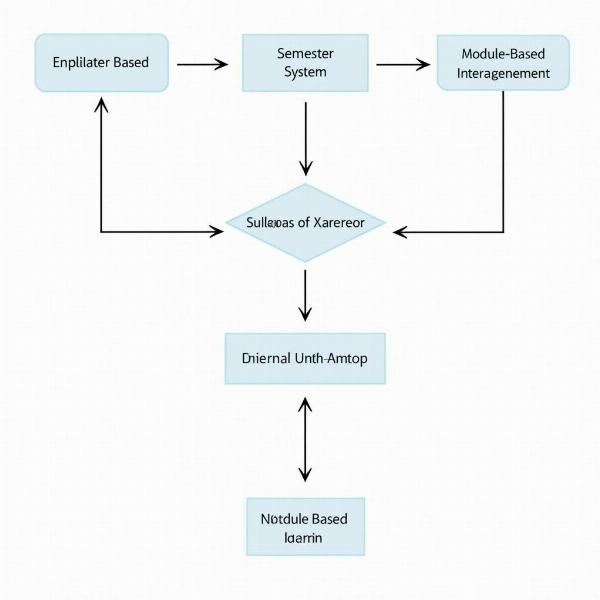Understanding the concept of a “split up syllabus” is crucial for students and educators in India. This term, often used interchangeably with “divided syllabus,” refers to the practice of breaking down a large academic curriculum into smaller, more manageable sections. “Split up syllabus meaning in Hindi” can be understood through various translations, depending on the specific context, such as “विभाजित पाठ्यक्रम” (vibhajit paathyakram) or “बांटा हुआ पाठ्यक्रम” (banta hua paathyakram). Knowing what a split up syllabus entails is essential for effective learning and teaching.
What Does a Split Up Syllabus Mean?
A split up syllabus takes a comprehensive course curriculum and divides it into smaller units, often based on topics, themes, or timelines. This division facilitates focused learning, allowing students to concentrate on specific areas before moving on to the next. It also allows for better assessment and tracking of progress. This is particularly relevant in the Indian education system, where structured learning is highly valued. “Split up syllabus” allows for a more organized approach to education.
Benefits of a Split Up Syllabus
- Improved Focus: By concentrating on smaller portions of the syllabus, students can delve deeper into each topic and gain a more thorough understanding.
- Easier Assessment: A split up syllabus makes it easier to assess student progress on specific topics, allowing for targeted interventions and support.
- Reduced Overwhelm: Breaking down a large syllabus into smaller chunks reduces the feeling of being overwhelmed, especially for complex subjects.
- Better Time Management: A divided syllabus helps students plan their study schedule effectively, allocating appropriate time to each section.
- Enhanced Learning Outcomes: By promoting focused learning and regular assessment, a split up syllabus can contribute to improved learning outcomes.
How is a Split Up Syllabus Implemented?
The implementation of a split up syllabus varies depending on the educational institution and the specific course. However, some common approaches include:
- Semester System: Dividing the academic year into semesters, with each semester covering a specific portion of the syllabus.
- Module-based Learning: Organizing the syllabus into modules, where each module focuses on a particular theme or topic.
- Unit-based Structure: Breaking down the syllabus into smaller units, with each unit covering a specific set of concepts or skills.
 Implementation of a Split Up Syllabus
Implementation of a Split Up Syllabus
Split Up Syllabus and Exam Preparation
A split up syllabus is particularly helpful for exam preparation. By focusing on smaller, manageable sections, students can plan their study schedule effectively and avoid last-minute cramming. This approach allows for more thorough revision and better retention of information. Understanding the “split up syllabus meaning in Hindi” – whether it’s “विभाजित पाठ्यक्रम” or “बांटा हुआ पाठ्यक्रम” – empowers students to approach exams strategically.
Expert Insights
Dr. Asha Sharma, a renowned educationist in Delhi, states, “A well-structured, split syllabus is instrumental in fostering a deeper understanding of subjects. It allows students to absorb information more effectively and apply their knowledge practically.”
Professor Rajesh Kumar, a seasoned academician, adds, “The division of the syllabus into smaller, manageable units is a proven method for enhancing learning outcomes and reducing exam-related stress.”
Conclusion
A split up syllabus, whether referred to as “विभाजित पाठ्यक्रम” or “बांटा हुआ पाठ्यक्रम” in Hindi, plays a significant role in structured and effective learning. By dividing a large curriculum into smaller, more manageable parts, it enables students to focus their efforts, track their progress, and achieve better learning outcomes. Embracing this approach can significantly enhance the educational experience for both students and educators in India.
FAQ
- What is the meaning of a split up syllabus? A split up syllabus is a curriculum divided into smaller, manageable sections for better learning and assessment.
- Why is a split up syllabus beneficial? It improves focus, eases assessment, reduces overwhelm, and enhances learning outcomes.
- How is a split up syllabus implemented? Common methods include the semester system, module-based learning, and unit-based structures.
- How does a split up syllabus help with exam preparation? It allows for focused study, effective time management, and thorough revision.
- What is the Hindi translation of split up syllabus? It can be translated as “विभाजित पाठ्यक्रम” (vibhajit paathyakram) or “बांटा हुआ पाठ्यक्रम” (banta hua paathyakram).
- Is a split up syllabus used in all Indian educational institutions? While widely adopted, the specific implementation varies across institutions and courses.
- Where can I find more information about syllabus structuring? Educational websites, academic journals, and institutional resources often provide detailed information.
Meaning-Hindi.in is your trusted partner for all your Hindi translation needs. We offer a wide range of services, including business and commercial document translation, certified and legal document translation, technical and user manual translation, website and localization translation, educational and academic document translation, and express translation services. Our expertise in various specialized fields ensures accurate and culturally sensitive translations. Contact us today at [email protected] or +91 11-4502-7584 to discuss your translation requirements. Meaning-Hindi.in is dedicated to delivering high-quality translations that bridge language barriers and facilitate effective communication.